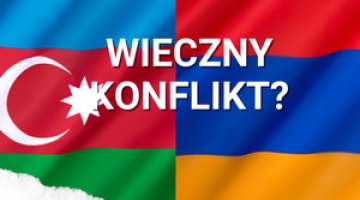Nagorno-Karabakh: what is Russia up to?
The clashes between Azerbaijan and Armenia from 2 to 5 April were accompanied by unprecedented activity by Moscow, which has allowed it to dominate the Karabakh peace process at this stage. Russia brought about a ceasefire in Nagorno-Karabakh on 5 April, and then developed a diplomatic campaign which, as its representatives stated, was aimed at a long-term settlement of the conflict. It seems that in the near future Russia will present a peace plan, which may include the following elements: the restoration of Baku’s control over some of the so-called ‘occupied territories’ (outside Karabakh) which were taken over by the Armenians, as well as security guarantees for the unrecognised Republic of Nagorno-Karabakh. The plan will also most likely include the introduction of Russian peacekeeping forces into the zone of conflict. Everything indicates that formally Moscow intends to pursue its objectives within the framework of the existing international formats, especially the OSCE’s Minsk Group, which it co-chairs with France and the United States. This would allow it to rebuild its image as a regional power taking responsibility for its neighbourhood, and to gain recognition for its effective mediation.
The effective implementation of this hypothetical scenario would mean an increase in Russian influence throughout the South Caucasus, at the expense of that of other players, particularly Turkey and the West. Such influence would allow Moscow – for the first time since the fall of the Soviet Union – to gain control over the main regional transport routes, both north/south and east/west.
Medvedev’s shuttle diplomacy
Russia was the first to react to the resumption of fighting in Nagorno-Karabakh. Other countries and international organisations did so only later, and their reactions were limited to calls to stop the fighting. On 2 April, President Vladimir Putin made a statement on the Karabakh crisis, and Russia’s Foreign and Defence Ministers, Sergei Lavrov and Sergei Shoigu, held telephone conversations with their counterparts in Armenia and Azerbaijan. Over the next three days there was a series of phone calls between Vladimir Putin and the Presidents of the two countries involved, Serzh Sargsian of Armenia and Ilham Aliyev of Azerbaijan; moreover, the chiefs of general staff of the armed forces of Armenia and Azerbaijan visited Moscow, during which the ceasefire was negotiated.
The key meetings seem to have taken place after the ceasefire. On 6 April Lavrov visited Baku, and on 7/8 April Prime Minister Dmitri Medvedev visited first Yerevan and then Baku (also on 8 April, Lavrov met Armenia’s head of diplomacy in Moscow during a previously scheduled meeting of the council of the CIS’s foreign ministers). These talks focused on the Russian peace plan for Karabakh. After these visits, Medvedev said that Moscow’s goal was to find a definitive solution to the conflict, and that in view of the close ties and strategic relationships connecting it with both countries, Russia is a “natural” intermediary. Both Medvedev and Deputy Prime Minister Dmitry Rogozin, who is in charge of the military-industrial complex, confirmed that Russia will continue to sell weapons to both countries, which is intended to ensure a balance of forces between the parties to the conflict.
Russia’s diplomatic offensive showed that it has both the political will and the instruments to stop the war and impose its mediation on the parties to the Karabakh conflict. At the same time, Moscow’s successful intervention has revealed the weakness of the other intermediaries (including the other co-chairs of the OSCE’s Minsk Group), who were unable to prevent the outbreak of fighting, bring about its suspension, or impose their own agenda on the peace process.
Possible variants of the resolution
The Russian peace plan may contain elements proposed in previous years by the OSCE’s Minsk Group: the return to Baku’s control of ‘occupied lands’ bordering Karabakh which were taken over by Armenian forces, like Nagorno-Karabakh itself, during the war of 1992-4 (with the exception of the so-called Lachin corridor and the Kelbajar area, which provide a land link between Karabakh and Armenia); security guarantees for Karabakh by granting it some temporary status (for example, as a full participant in the peace talks); and unblocking lines of communication, including the resumption of rail links between Azerbaijan and the autonomous Republic of Nakhchivan (via Armenia), and between Yerevan and the Armenian town of Meghri (via Nakhchivan), which have been idle since the beginning of the 1990s.
Moscow’s plan is for compliance with the cease-fire to be monitored by a peacekeeping force deployed between the Armenian and Azerbaijani armies’ positions; at the moment they are directly facing each other, which is conducive to various kinds of provocations. These forces could formally be nominated by the CIS, as in the case of the forces stationed in Abkhazia between 1994 and 2008; in practice, however, they would most likely consist of Russian soldiers alone, perhaps with the symbolic participation of contingents from other countries. The Armenian president has already expressed his initial consent to the presence of a peacekeeping force.
If this scenario is implemented, Azerbaijan would regain a part of its lost territory, and Armenia would gain security guarantees for the internationally unrecognised Republic of Nagorno-Karabakh (this would mean that Nagorno-Karabakh’s final status is likely to remain an open question, and that a final resolution to the matter would be postponed to the further future). It is Russia, however, which would stand to gain the most; thanks to its peacekeeping force it would have a direct influence on the situation in the conflict zone. This would be an additional, important instrument for putting pressure on both countries.
Much indicates that Moscow’s minimum requirement at this stage of the plan is the introduction of peacekeeping forces into the conflict area, which Russia has been demanding since the 1990s. The maximum would be to embrace Azerbaijan (and ultimately the whole of the South Caucasus) into Russia’s integration initiatives, especially persuading it to join the Eurasian Economic Union, and perhaps also the Collective Security Treaty Organisation (Armenia is already a participant in both of these Moscow-dominated organisations). This would give Russia – regardless of what attitude Georgia might take – domination of the South Caucasus, allowing for effective control over the transport routes running both north/south and especially east/west (oil pipelines and gas pipelines, power lines, railways, roads). Such a scenario would mean the failure of a quarter-century of efforts to build a transit corridor independent of Russia which would link Central Asia and the South Caucasus with Europe. The role of the other players in the region (the West, Turkey, Iran) would be further reduced, and the room for manoeuvre of the Caucasian countries would be limited, particularly in the case of Armenia; its chances of normalising its relationship with Turkey would drop practically to zero.
Moscow’s second approach
In order for the international community, especially the other players in the region, to accept Russia’s dominant position in the peace process, Moscow will most likely use the existing formats, especially the OSCE’s Minsk Group, to resolve the conflict. These formats will be, however, treated instrumentally as ‘billboards’ for Moscow’s own proposals. An extraordinary meeting of the Group took place on 9 April in Yerevan, during which the co-chairmen recalled that it operates on the basis of three principles: the territorial integrity of states, the right of peoples to self-determination, and the prohibition of the use of force or the threat of its use. As it seems, the EU and the US are willing to accept the solution Moscow has devised, even though it means a further reduction of their influence in the region; while Russia’s regional rival Turkey – which during the recent crisis declared itself in favour of the Azerbaijani side more emphatically than usual, while at the same time blaming the Kremlin for its role in aggravating the conflict – will be unable to oppose it.
Moscow is attempting to settle the Karabakh conflict on its own terms for the second time. The previous one took place in the autumn of 2008, after the Russian-Georgian war, which demonstrated that Russia is ready to make armed interventions abroad in defence of its interests. On 2 November that year, the then President Russia Dmitri Medvedev managed to convince Presidents Sargsian and Aliyev to sign a joint declaration, in the Meyendorff Castle near Moscow, which expressed a willingness to work for a peaceful solution to the conflict and stressed the importance of the OSCE’s Minsk Group (which, for its part, evaluated the document very positively). Meetings between the three presidents were to have continued (Medvedev, and then Putin, met Aliyev and Sargsian in the new format several times), but did not lead to a breakthrough as a result of the reluctance of Yerevan and Baku to make concessions, and then of Moscow’s inability to impose its will on them.
Unlike previous attempts, the present effort seems to have a chance of success, as both the internal situations in Azerbaijan and Armenia and the regional context have changed. Both countries are going through serious economic and social crises (exacerbated, in the case of Azerbaijan, by low crude oil prices); nor can they count on support from other external actors (Yerevan has no room for manoeuvre in its foreign policy; Baku’s relationship with the West is strained due to human rights issues). The rise of Iran’s importance and ambitions since the abolition of sanctions has also motivated Russia; Tehran also declared (in January this year) its desire to mediate in the Karabakh conflict, which further encouraged Moscow to implement a policy of ‘facts on the ground’, as it wants to avoid another player from joining in the game. A solution to the Karabakh conflict would also boost Russia’s position in its conflict with Turkey. Moreover, Moscow will most likely want to take advantage of the current electoral campaign in the United States to settle the conflict before a new President is chosen (November 2016) and inaugurated (January 2017).




